Protecting your Home Against Termites
ENTFACT-605: Protecting your Home Against Termites | Download PDF
by Michael F. Potter, Extension Entomologist
University of Kentucky College of Agriculture
The Entomology Department often receives calls from people wanting to know how to protect their home from. Homeowners can reduce the risk of termite attack by following these suggestions:
1. Eliminate wood in contact with the ground. Termite problems often occur when wood components of the building are in direct contact with soil. Earth-to-wood contact affords termites’ easy access to food, moisture and shelter, and direct, hidden entry into the building. Wood siding, door and window frames, etc. should be at least six inches above ground level. Eliminating wood-to-soil contact may require regrading or pulling soil or mulch back from the foundation, cutting the bottom off wood latticework, or supporting steps or posts on a concrete base. Posts or stairs embedded in concrete are also vulnerable to termite attack since they usually extend all the way through the concrete to the soil. Contrary to popular belief, pressure-treated wood is still vulnerable to termite attack; termites often enter the wood through cracks and cut ends, or build tunnels over the surface.

Fig. 1: Wood-to-ground contact aids entry into buildings.
2. Do not let moisture accumulate near the foundation. Termites are attracted to moisture and are more likely to infest if the soil next to the foundation is consistently moist. Water should be diverted away with properly functioning gutters, downspouts and splash blocks. Leaking faucets, pipes and air conditioning units should be repaired, and the ground next to the foundation should be graded (sloped) so that surface water drains away from the building. Homes with poor drainage may need to have tiles or drains installed. Lawn sprinklers and irrigation systems should be oriented to minimize water puddling near the foundation.
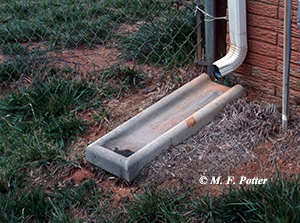
Fig. 2: Divert water away from foundations. Downspout splash blocks are helpful, but this one is facing in the wrong direction.
3. Reduce moisture and humidity in crawl spaces. Most building codes call for one square foot of vent opening per 150 square feet of crawlspace area. For crawlspaces equipped with a vapor barrier (see below), the total vent area often can be reduced to one square foot per 300 to 500 square feet of crawlspace area. One vent should be within three feet of each exterior corner of the building. Vents should be kept free of leaves, dirt, and debris, and should not be obstructed by vegetation. Moisture and humidity in crawl spaces can further be reduced by installing 4-6 ml polyethylene sheeting over about 75 percent of the soil surface. The soil cover will act as a vapor barrier to reduce evaporation from the soil and condensation of moisture on joists and subflooring. Vents and vapor barriers are installed by most pest control companies.
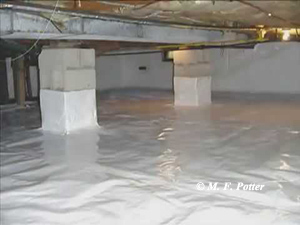
Fig. 3: Moisture in crawl spaces can be reduced by installing plastic sheeting.
4. Never store firewood or wood debris against foundations or inside crawlspaces. Firewood, lumber, cardboard boxes, newspapers, and similar materials attract termites and provide a source of food. Stacked against foundations they also offer hidden entry into the structure and may allow termites to bypass surrounding soil treated with a termiticide. Vines, ivy, and other dense plantings touching the house should be avoided as well. Where practical, remove stumps and dead roots around and beneath buildings, and any form boards left in place after the building was constructed.
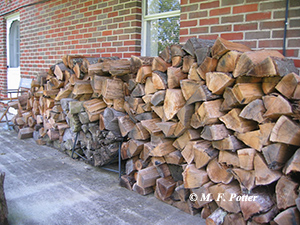
Fig. 4: Don’t stack wood against the side of a building.
5. Use mulch sparingly, especially if you already have termites or other conducive conditions. Many people use landscape mulch for its aesthetic and plant health benefits. Improper usage, however, can contribute to termite problems. Termites are attracted to mulch primarily because of its moisture-retaining properties, and the insulation it affords against temperature extremes. The mulch itself is of poor nutritional quality to termites and a non-preferred source of food. Since the moisture retaining properties of mulch are more of an attractant than the wood itself, it makes little difference what type of mulch is used (cypress, pine bark, eucalyptus, etc.). Crushed stone or pea gravel are comparable to wood mulch in terms of attraction, since they also retain moisture in the underlying soil. Where mulch is used, it should be applied sparingly (a couple inches is usually adequate), and should never be allowed to contact wood siding or framing of doors or windows.
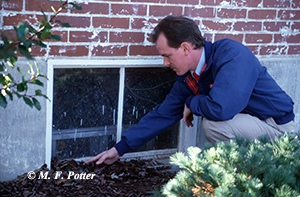
Fig. 5: Do not allow mulch to contact wood siding, doors and windows.
6. Consider having the home treated by a professional pest control firm. Buildings have many natural openings through which termites can enter, most of which are hidden. While the above measures will help make the structure less attractive to termites, the best way to prevent infestation is to protect it with a termiticide. Preventively treating a home for termites is a prudent investment, especially if the structure has had no prior history of treatment. If a pest control firm previously treated the building, it is a good idea to maintain the warranty by paying the annual renewal fee. Should termites re-infest -- which can happen even if the treatment was performed correctly, the company will return and retreat the affected area at no additional charge.
Whether one chooses to have their home preventively treated for termites, it helps to know the telltale signs of infestation:
• Pencil-wide mud foraging tunnels on foundations, piers, sills, joists, etc.
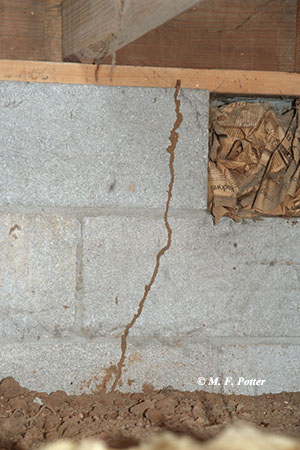
Fig. 6: Telltale signs of termites: mud tunnels
• Winged "swarmer" termites, or their shed wings, on windowsills and along the edges of floors.

Fig. 7: Telltale signs of termites: swarmers
• Damaged wood hollowed out along the grain, lined with bits of mud or soil.
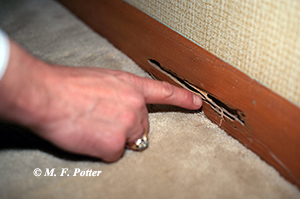
Fig. 8: Telltale signs of termites: damaged wood with soil in the galleries.
Detecting hidden termite infestation requires a trained eye. Pest control companies often offer free termite inspections and will alert homeowners to any conditions they uncover which are conducive to termite attack.
Termite prevention and control are complex subjects. For more information, see our other entomology extension publications, Entfact 604: Termite Control: Answers for Homeowners, and Entfact 639: Termite Baits: A Guide for Homeowners.
CAUTION: Some pesticides mentioned in this publication may not be legal in your area of the country. If in doubt, please consult your local cooperative extension service or regulatory agency. Furthermore, ALWAYS READ AND FOLLOW LABEL DIRECTIONS FOR THE PRODUCT YOU ARE USING.
Please note that content and photos in this publication are copyrighted material and may not be copied or downloaded without permission of the Department of Entomology, University of Kentucky.
